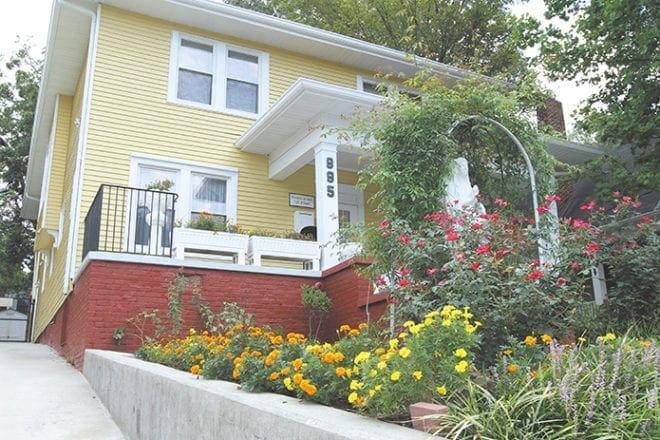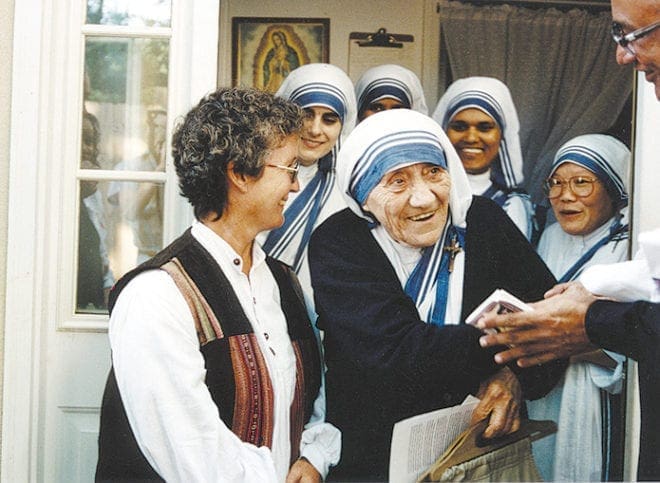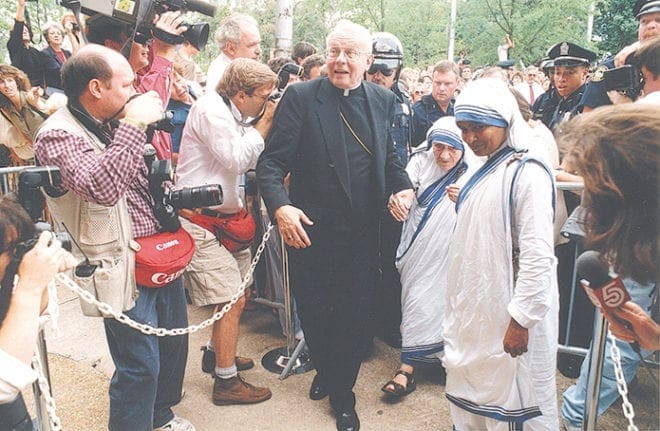Sister Faustina Maria, MC, left, collects and holds the plastic bags as Irene Rivas, second from left, her 12-year-old daughter Miriam, Missionaries of Charity Sister Leo Grace and Rivas’ 13-year-old son Cristofer grab potatoes to distribute to families, along with other food, at the Colony South mobile home park in southeast Atlanta. Rivas, who lives at the mobile home park with her husband and eight children, serves as a liaison between the families and the sisters. The sisters distribute food there on special occasions like Christmas or Easter, and the upcoming canonization of Mother Teresa became another reason to do so on Aug. 27. Photo By Michael Alexander
Atlanta
Sisters spread joy of sainthood of Mother Teresa
By NICHOLE GOLDEN, Staff Writer | Published September 1, 2016
ATLANTA—An invitation is posted on the side door of the Gift of Grace House in Atlanta, the home provided by the Missionaries of Charity for indigent women with AIDS.
The simple announcement invites all to local Masses to celebrate the Sept. 4 canonization of the congregation’s foundress, Blessed Teresa of Kolkata.
The Gift of Grace House, situated on tree-lined St. Charles Avenue in Atlanta, is typically a hub of neighborhood activity.
On a recent morning, the sisters welcomed volunteer drivers who would take several of them to pick up food for distribution to refugee families. Others stayed behind to care for residents, while another departed to pray the rosary with mothers in Forest Park.
“Every day is exciting,” said Sister Dominga, a member of the Missionaries of Charity for 37 years. “We just had a five-week summer camp.”
In addition to the work at Gift of Grace House, the white and blue sari-clad sisters help families at Colony South trailer park and are catechists at San Felipe de Jesus Mission, both in Forest Park, and aid Burmese refugees in Clarkston with after-school programs and English classes.
They pray the rosary regularly at an Atlanta neighborhood soup kitchen, at the invitation of a Pentecostal minister.
The sisters spent Saturday, Aug. 27, the baptism day of Mother Teresa, distributing cooking oil, sugar, rice, coffee and chicken to refugees from an apartment in Clarkston and at Colony South. The nuns usually have food distributions for Christmas or Easter. This time, they organized the giveaway to celebrate the canonization.

Through the generosity of a number of volunteers, Atlanta’s Gift of Grace House opened in 1994 on St. Charles Avenue as a place where the Missionaries of Charity could serve impoverished women with AIDS. Today the outreach ministry of seven sisters extends beyond the house and to the communities of Clarkston, southeast Atlanta and Forest Park. Photo By Michael Alexander
Seven Missionaries of Charity are assigned to Atlanta. A live-in housemother helps with overnight duties. The sisters live in a convent behind Gift of Grace House.
A garden path leads to the convent entrance. The “green-fingered” Sister Maxmilina is primary caretaker of the fig and pear trees and jalapeño plants in the garden.
In the hallway outside the convent chapel is an arrangement of black and white photos of Mother Teresa as a young girl and throughout the years.
The presence and example of Mother Teresa are felt and acknowledged. A portrait of her hangs inside the chapel where the nuns kneel on the concrete floor for Mass and prayer. In addition to daily prayer, Thursdays are a day of prayer for the Missionaries of Charity.
Sister Dominga shared a recent experience of their superior, Sister Justus.
Every year the Missionaries take young people from the communities where they serve to the Steubenville Atlanta Youth Conference, said Sister Dominga.
During a time of adoration at the youth conference, the priest stood before each person with the monstrance holding Jesus in the Blessed Sacrament.
The next morning, a woman attending Steubenville Atlanta approached Sister Justus and told her she had had a vision of Mother Teresa standing next to the priest with the monstrance.
In her mind, she questioned why Mother Teresa was there, and she heard the answer, “Where my sisters are, I am, too.”
Atlanta doctor asked Mother Teresa for sisters
Archbishop Eugene A. Marino, SSJ, wrote to Mother Teresa in 1988 to invite the Missionaries of Charity to Atlanta. Mother Teresa replied but was unable to send members of the congregation at the time.

Mother Teresa greets people after Mass June 13, 1995, for volunteers at the Gift of Grace House in Atlanta. Dr. Sharne Sheehey, left, of Grady Hospital’s Infectious Disease Clinic, asked Mother Teresa for the Missionaries of Charity’s help with homeless AIDS patients. Photo By Gretchen Keiser
Dr. Sharne Sheehey, a physician at Grady Hospital’s Infectious Disease Clinic, renewed the appeal in 1992. She wrote a letter about the HIV/AIDS crisis among Atlanta’s homeless.
The doctor had provided medical care in Third World countries, including India. Her letter detailed how conditions in Atlanta were just as bad, said Sister Dominga.
Sheehey sought and received the support of Archbishop Marino’s successor, Archbishop James P. Lyke, OFM, because Missionaries of Charity only work in dioceses at the invitation of local bishops.
“Mother said, ‘Go and see what is happening’,” recalled Sister Dominga.
The Missionaries visited Atlanta that fall. They toured Grady with Sheehey and met with Archbishop Lyke, who was seriously ill with cancer.
Although his own condition was grave, the archbishop was overjoyed at the possibility of the Missionaries coming to the archdiocese.
“He was so sick. He emanated so much peace and joy,” recalled Sister Dominga.
Archbishop Lyke died the following month. The Missionaries of Charity formally arrived in 1993 to begin work.
The Gift of Grace House opened in 1994 after volunteers helped renovate the two-story home. It is a haven for 10 women who once lived on the streets.
Mother Teresa came to Atlanta in mid-June 1995 to mark the opening of Gift of Grace House. Archbishop John F. Donoghue celebrated Mass on the afternoon of June 12 at the Basilica of the Sacred Heart of Jesus. Mother Teresa addressed the congregation afterward.
In her remarks, she said that the aim of the Missionaries is to satiate the thirst of Jesus on the cross. The words “I Thirst” are imprinted on the wall behind the altar in the Missionaries’ chapel.
“Jesus came to give us the good news that God loves us and he wants us to love one another as he loves each one of us,” said Mother Teresa. “And to make it easy for us to love one another, Jesus said, ‘Whatever you do to the least, you did it to me. If you give a glass of water in my name, you give it to me. If you receive a little child in my name, you receive me’.”
Maria first heard of Jesus at this house
For Maria Diaz, 56, the Gift of Grace House has been home for six years.
The native of San Salvador, El Salvador, is unsure how long she lived on Atlanta’s streets or when she even arrived.
After years of being involved in drugs, alcohol and prostitution, she learned of Gift of Grace House through a social worker while hospitalized at Atlanta Medical Center.

When Maria Diaz came to Gift of Grace House six years ago, she said she arrived physically and spiritually empty, but with the influence of the Missionaries of Charity, today Diaz has a close relationship with Mary and Jesus, and you can often find her in the Gift of Grace House chapel praying. During times of intense prayer she will cling to the waist of the Blessed Mother or the feet of the crucified Jesus. Photo By Michael Alexander
Diaz had not heard of Jesus before finding Gift of Grace House.
“God changed my life. He gave me a new heart,” said Diaz.
The sisters taught her the mysteries of the rosary. “They showed me to pray the rosary,” said Diaz.
She spends three to four hours daily in the chapel for residents and calls it her “spiritual office.”
Diaz shows several scraps of folded, worn paper with scores of names. They are the people she prays for daily.
“She’s our prayer warrior,” said Sister Leo Grace, MC.
The past was a “nasty life,” in which “Diablo,” the devil, worked for her soul, said Diaz.
God gave her the Missionaries of Charity to show her the way to live.
“He picked me up out of the trash. He gave me a second chance in my life,” she said.
“Everything is for Jesus in this house. Now I have more discipline in my life.”
Diaz quit smoking three years ago and loves to help with cleaning tasks. She offers her work to God and excitedly shows her new broom and dustpan.
“I give you my day, my work,” she said, looking heavenward. “He gives me so much peace.”
Diaz said she now has compassion for others. She hopes the public will support the Missionaries of Charity who serve as their foundress did.
“Mother Teresa is one example for everybody. She opened the door for Jesus,” said Diaz. “The sisters make everything for Jesus.”
No matter how busy, everyone can give something to God. “You have five minutes,” said Diaz.
While her physical health is poor, Diaz is grateful for life. She enjoys sweeping outside and hearing birds or seeing a full moon.
“My body is sick, but my spirit wakes me up every day,” she said. “When I came here I had a spiritual infection.”
Diaz receives the sacrament of reconciliation often and compares it to a stained garment being made white.
“I’m working for humility. Before, I didn’t have humility,” she said.
Canonization in Year of Mercy
The Missionaries have helped other women in need. For one homeless woman, they provided a place to shower and cut her matted hair. She slept soundly for days, something she could not do out in the elements. The woman received some money and gave it all away. She later died of an aneurysm after leaving Gift of Grace.
“I think at the heart of our charism is to prepare people for death,” said Sister Dominga. “The poor . . . we learn a lot from them.”
At lunchtime Sister Leo Grace and Sister Maxmilina, MC, with pinafores over their saris, serve chicken and macaroni and cheese to the residents. One woman, unable to walk on her own, holds onto Sister Dominga’s shoulders to follow her to the table. The nuns feed her and say she is making progress weeks after arriving.
Before each meal, they recite in unison a prayer that Mother Teresa taught them: “Jesus in my heart, I believe in your tender love for me. I love you.”
They conclude with the intercession, “Blessed Mother Teresa, pray for us.”
One woman shows pictures of her grown children. She expresses sorrow for hurting them in the past and is trying to repair the relationships. The nuns give undivided attention when she needs a listening ear—a quality many say Mother Teresa exemplified.
Sister Leo Grace and Sister Maxmilina are natives of India. They sing while they fetch juice glasses and empty wastebaskets.
“In December, it will be exactly 10 years,” said Sister Leo Grace of her time with the Missionaries of Charity.
An image of Mother Teresa holding a malnourished child drew her to the work.
“I saw the picture of Mother carrying the baby,” she said.
Mother Teresa did not enjoy having her photograph taken but would pray for the souls in purgatory when agreeing to have a photographer document the work, said Sister Dominga.
They believe it fitting the canonization will take place within the Year of Mercy as Mother Teresa demonstrated the corporal and spiritual works of mercy.
Sister Maxmilina was inspired since childhood to the religious life, and it was an uncle who first told her about Mother Teresa.
“They called my name and said you’re going to Atlanta. It is God’s will,” she said, smiling.
Their saris feature three blue bands, symbolizing vows of chastity, poverty and obedience.
Sister Dominga said Missionaries of Charity also take a fourth vow of “free service to the poor.”
She noted that saris can be made from a variety of fabrics, including silk. Theirs are basic, inexpensive cotton.
“Our leprosy patients make them,” said the sister.
A cross, worn by the Missionaries on the left shoulder, symbolizes Jesus on the cross as the key to the heart.
Simple, humble acts
David Caron has long volunteered for Gift of Grace House. He coordinated the AIDS ministry at the Basilica of the Sacred Heart when the sisters were beginning their work. He is struck by their humility.
“We must decrease so that he can increase. They live it,” said Caron.
He plays the organ at the home for special Masses or funerals. Before medical advances in the treatment of AIDS, there were many resident funerals in the early days.
“It’s not a chore,” said Caron of his role as organist. “It’s simple. They just want to keep it simple. It’s very spiritual, very prayerful.”
Those who attend Mass at the house are not just fulfilling an obligation, noted Caron.
“Everyone who is there wants to be there,” he said.
The sisters live without television or air conditioning in the convent. “They live like the poor,” he said.
When Mother Teresa visited Atlanta, Caron was a member of the Sacred Heart choir and had a prime spot when she entered the church.

Archbishop John F. Donoghue leads Mother Teresa into Sacred Heart Church, Atlanta, on June 12, 1995. The foundress of the Missionaries of Charity came to dedicate the Gift of Grace House to serve homeless women with AIDS. An estimated 1,500 people filled the church and streets outside to see her and hear her words. Photo By Linda Schaefer/Archdiocese of Atlanta
“When she came in the door, I was the second person to greet her,” he said. “I bent down so I could look her in the eyes. It was like looking into the eyes of God. You could feel the love.”
Caron saw Mother Teresa again in 1996 when she visited New York for the 25th anniversary of the Missionaries of Charity in the United States and Canada.
Caron said the sisters are like joyful schoolgirls. “They are the happiest bunch of women,” he said.
He attributes this happiness to total dependence on God.
“I think it’s their prayer life. They won’t ask for anything,” he said.
Caron once dropped off several weeks worth of paper towels and cleaning supplies.
“We unloaded two vans full of stuff. I came back a week later and it was gone,” he said.
Caron asked the sisters what happened to the supplies.
“We gave it to the poor,” they told him.
16-year volunteer helps
Sharon Sequeira, a parishioner of St. Patrick Church in Norcross, has volunteered at Gift of Grace for more than 16 years.
Before moving to Atlanta, Sequeira helped at a Missionaries’ soup kitchen in Michigan. When she found out the sisters worked in Georgia, Sequeira offered to cook Indian food for the nuns.
A native of India, she befriended Father Joe Mendes, a Missionary of St. Francis de Sales, who had served as a retreat director for the sisters.
He encouraged more of a commitment on Sequeira’s part.
“They need someone to stay the night,” he told her.
Although she had a young daughter at the time, Sequeira decided to stay once or twice a week.
“I would feed my family and leave at five o’clock,” said Sequeira.
She would arrive at Gift of Grace around 6 p.m., stay overnight and leave early the next morning. She volunteered in this capacity for five years.
She continues assisting in other ways.
“The little we can do is help them,” she said. “They’re very genuine, very pure.”
Sequeira recognized she was blessed with good parents, a husband, children and in-laws. She would often get up in the middle of the night to talk with residents who needed it.
“Many things we take for granted. Many of them don’t sleep in the night,” she said about the residents. “God has blessed me; it’s such a protected life.”
The first time a resident died, Sequeira became upset and asked the sisters, “Could I have done anything better?”
They told her she had done her best, giving the woman “a peaceful way of going back home.”
Sequeira feels very “connected” to the soon-to-be saint who worked in her native country.
In 1983, Sequeira’s husband, Danny, was a student in Calcutta. He decided he wanted to meet Mother Teresa.
“My husband met her and sat and had a personal talk with her,” shared Sequeira. “He went and rang the bell.”
Mother Teresa was in prayer, and the sisters told him to wait on a bench. She came out to meet him after prayers.
“They both sat on that bench. He couldn’t talk he was so dumbfounded,” she said.
Danny Sequeira eventually asked her, “Why do you do all these things?”
“She just pointed to the tabernacle,” said Sequeira.
Mother Teresa then said, “It’s all for his love and sacrifice.”
The Basilica of the Sacred Heart, Atlanta, has a parish ministry supporting the Gift of Grace House with volunteer help, visitation and meals. For information, contact Jim and Myra Kucera at 404-355-4313, jimkucera@yahoo.com or myra.kucera@yahoo.com.
Photographs taken by Georgia Bulletin photographer Michael Alexander are available for purchase.